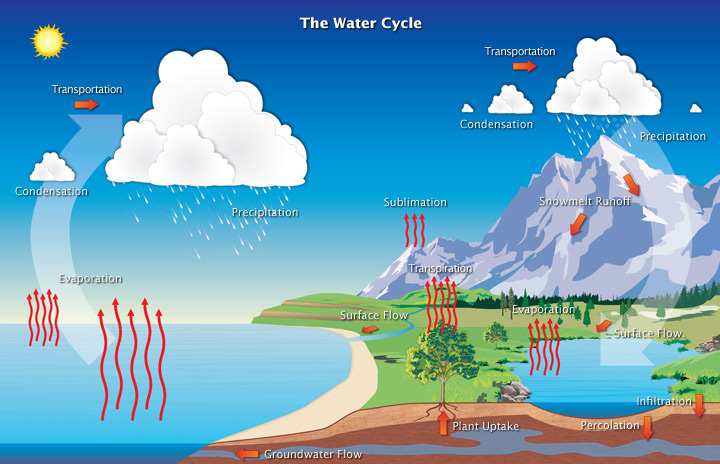Water cycle is circulation of water in environment. Water from land or sea surface evaporates due to solar energy. Water vapor rises into the atmosphere, cools and after a particular level is converted to water, snow, etc. (condensation). A part of the water that falls on the land is evaporated back to the atmosphere. Some water seeps into the soil to form ground water and the remaining flows over the land in the form of streams and rivers from where it evaporates again.
Human Impact and Hydrological Cycle
The total amount of water on the earth’s surface remains
constant. Human actions bring about serious alterations in the natural
hydrological cycle. The demand for water has grown with the increase in
population not only for domestic use, but also for agricultural, industrial and
economic growth.
Water use has also resulted in larger discharge of waste
water from domestic, industrial, agricultural and other sources. These discharges
are mixed with various types of pollutants, hazardous chemicals and bacteria.
This results in reduction in availability of drinking water.
Large urban centers lead to increase in surface runoff
through drains and sewer systems thus increasing events of urban flooding.
To provide water dams were constructed. The dams change the
flow of water and affect the amount of fresh water flow to the sea.
Agricultural activities have seriously hampered natural
hydrological cycle. Clearing of forests for agriculture leads to increase in
soil erosion. Use of fertilizers, insecticides, pollutes the natural system.
Extraction of ground water for irrigation or drinking may
lead to depletion or sinking of land damaging property. Human activities have
polluted ground water e.g. industrial chemical sewage and other pollutants.
Activities like mining also lead to alterations in the
natural water cycles by pumping out large proportion for dewatering the mines
and washing of minerals. Both these activities release water hat has high
levels of mineral content thus polluting streams.
Oil slicks develop due to spills of oil from tankers and
containers used for transport and storage. Oil impairs the exchange of gases
and destroys natural systems. This results in death of marine animals.
Changes in the natural water or hydrological cycle can also
result in contributing towards global warming, disruption in climatic systems,
erratic and sudden occurrences of floods, cyclones, etc.

No comments:
Post a Comment